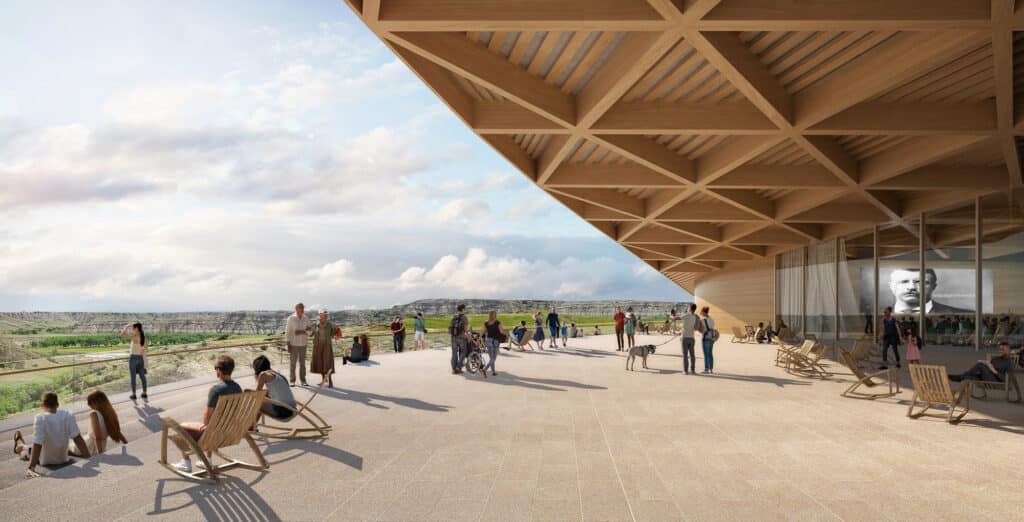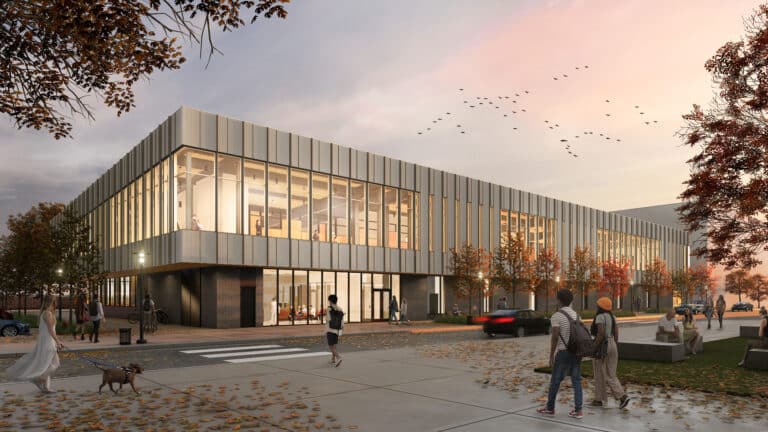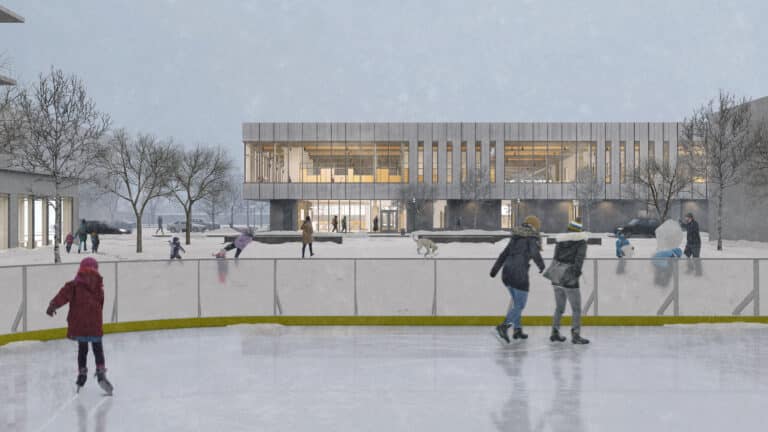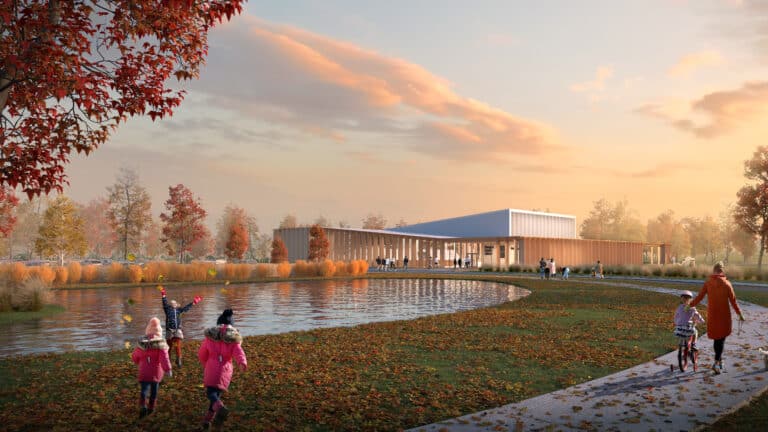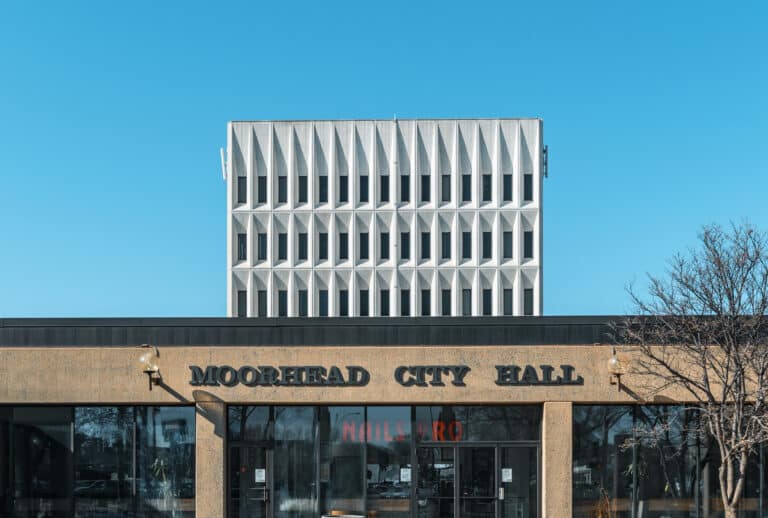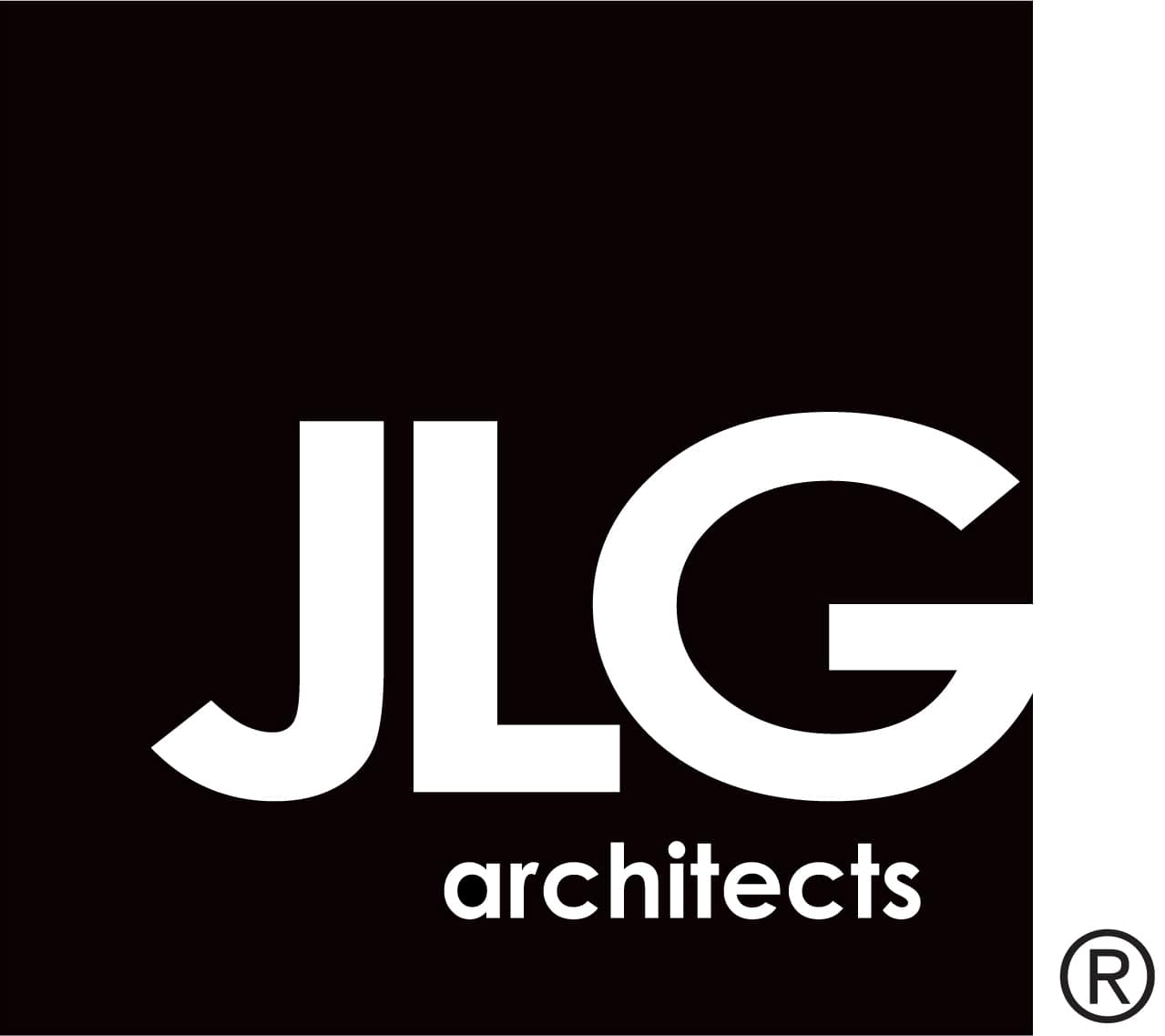Nearly 140 years after Theodore Roosevelt marked his territory as American’s original conservationist, his bold legacy lives on to catalyze the future. Emerging from Roosevelt’s beloved Badlands in rural North Dakota, the Theodore Roosevelt Presidential Library (TRPL) is destined to extend T.R.’s vision into the next century of conservation focused on circularity of carbon. The project’s architectural team —international Design Architect and Design Landscape Architect Snøhetta, Architect-of-Record JLG Architects, Landscape Architect-of-Record Confluence, and Construction Manager JE Dunn — are preparing to make history.
TRPL isn’t constructed to commemorate our 26th President, its very construction communicates the value of global conservation and rural restoration unearthed in Western North Dakota.
Trailblazers
Designed by Snøhetta, with local Architect-of-Record JLG Architects, TRPL molds a sustainable library from the steep, naturally derived contours of the rugged landscape. Intentional architectural elements mimic the Badlands features, inviting visitors to immerse themselves in the very experience that inspired T.R.’s conservation values. The ultimate goal is to create a harmonious visual and emotional connection with nature… not compete with its dynamic.
TRPL seeks to establish the next century of conservation through extraordinary feats of sustainable integration in both construction and design. The Library is pursuing several legendary firsts, bolstering its goals to be a ‘living library,’ embrace the Badlands, honor ecological systems, and become a model for sustainable living.
To live out these lofty goals, the Library is striving to achieve full Living Building Challenge (LBC) certified; first in North Dakota and a first amongst presidential libraries nationwide. Even more impressive is TRPL’s goal of achieving three concurrent certifications at the highest level, including LBC, LEED Platinum, and SITES Platinum.
Changing Business as Usual
Globally, LBC is the most rigorous and difficult to achieve, hence the word ‘challenge’ in its name. It’s not simply a checklist of optional tasks, it intends to change business as usual – in the way architects design, the way products are provided for construction, and the way buildings are operated. LBC “imperatives” and achievement is performance verified, unlike more common design intent-focused certifications.
To achieve LBC certification, the team is following the organization’s seven “petals,” to address both the design and operation of the building. Within these petals, there are 20 imperative categories focused on net positive outcomes.
Living Building Challenge: 7 Petals
- Place: Restoring a healthy inter-relationship with nature
- Water: Creating developments that operate within the water balance of a given place and climate
- Energy: Relying only on current solar income
- Health & Happiness: Creating environments that optimize physical and psychological health and well-being
- Materials: Endorsing products that are safe for all species through time
- Equity: Supporting a just and equitable world
- Beauty: Celebrating design that uplifts the human spirit

A Living Library
Once the doors open on July 4, 2026, and the LBC performance period has commenced, TRPL will be a “living” building, a brilliant example of energy independence – making more energy than it consumes.
Instead of doing less bad or incremental improvement, TRPL seeks to be better than having no building at all. Picture a regenerative building that gives back, contributes, and connects occupants to light, air, food, nature, and community. Overall, TRPL will demonstrate an innovative way to achieve positive impact and harmonious interaction for humans and our natural systems.
TRPL’s environmental goals are driven by the Theodore Roosevelt Presidential Library Foundation, with design and construction firms specifically chosen to match the Foundation’s ambition. Together, TRPL will chart a new course, carrying forward the Foundation’s deep commitment to sustainability and the deep-rooted legacy of Theodore Roosevelt.
On this Medora site, the Foundation’s objectives are transformative, particularly to its rural environment negatively impacted by climate change, droughts, fires, and overgrazing. The Badlands surrounding the small town of Medora are considered a national treasure, and the Foundation intends to keep it that way. Working closely in adherence with the Foundation’s three Pillar Principles of Conservation, Leadership, and Citizenship, the team is aiming for a long list of firsts, including:
- First presidential library pursuing three concurrent certifications at the highest level, LBC Full certification, LEED Platinum, and SITES Platinum
- First newcommercial building LBC registered in ND
- First of its kind soil organic carbon (SOC) sequestration approach in the region with new standards in progress with ILFI and CBE.
- First total carbon positive in ND
- First TR20 biophilic approach connecting people to nature through data-based statistics
- First museum pursuing full LBC
- First of a few Kitchens of the Future—all electric commercial kitchen
The Native Plant Project
The Badlands site of the Theodore Roosevelt Presidential Library is an ideal introduction to conservation of natural prairie ecology, offering immersion into the site’s majestic plateaus, jagged peaks, rolling prairie, and intertwined riverscapes connected to the 144-mile Maah Daah Hey trail system. It’s also a site challenged with national park requirements in a rural setting with a harsh northern climate and remote landscape. Overcoming the challenges, the team is building on the values of a rural, resource-limited site, adhering to the pioneering ideals of Roosevelt’s conservation efforts and the everyday efforts of local farmers and ranchers.
Land management and prairie restoration efforts at TRPL’s 100-acre site, known as “The Native Plant Project,” are led by a team of volunteers, ecologists, and landscape architects, now embarking on their third summer of native plant restoration. The teams have been collecting seeds in the Medora grasslands and around T.R.’s Maltese Cross and Elkhorn Ranch properties. The seeds then travel to the NDSU Extension research center in Hettinger, ND, where they are dried, catalogued, germinated, then multiplied in greenhouses before returning to their Badlands roots.
The restored native prairie will aid the development of healthy native soils, which over time will sequester carbon and develop a complex community of soil microbes and fungi that will improve the vegetation, habitat quality, and resilience of the landscape. While animals will benefit from a managed grazing plan, pollinators will find a more diverse assemblage of native flowering plants – providing nectar and pollen resources critical for survival. By increasing native plant diversity, the landscape will be able to respond more favorably to unpredictable environmental factors and persistent climate change.
Restoration in Real-Time
Envisioning the landscape as the library enables TRPL to be a teaching tool for sustainable living.
TRPL’s design concept embraces advanced digital technology within a dynamic environment of rammed earth walls, low-carbon concrete, and mass timber construction, empowering impactful storytelling that narrates the human journey beyond the presidency. The Library will be a progressive expression of our environment that cultivates healthy, active citizens who celebrate the outdoors, value of conservation, and enter their own arena of community action with an evolved sense of indoor and outdoor systems.
TRPL’s sustainability integration will be visible upon arrival throughout the site and building. Spanning the tour’s educational and outdoor aspects will be custom signage and TR20 data, opt-in apps to make the visitor experience carbon neutral, and visible dashboards showing the real-time building status via on-site locations and TRPL’s website.
Pivotal to the experience will be outdoor engagement, with a landscape accessible to all and reachable by foot, bicycle, and horseback – all connected to the Maah Daah Hey Trail system. The Library’s walkable and ADA-accessible rooftop, primarily covered in grasses, will invite visitors to follow the growth of over 400,000 native prairie plugs that have been hand-collected and planted on the TRPL roof and bioswales. The prairie boardwalk will connect visitors to the Library’s landscape and scenic views with a plaza and seating lawn, a bridge, a sunken path, a grassland pause, a sweeping overlook, and a shaded trailhead.
This indoor-outdoor vision builds endless educational opportunity, ready to welcome global thought leaders, outdoor expeditions, nature classrooms, conservation corps, and photography safaris, to name just a few.
Paving the Way
Achieving full Living Building Challenge, LEED Platinum, and SITES Platinum certifications will be a monumental step in the right direction, overriding the challenges our collective team has faced in delivering a high-tech and high-energy building on a rural, resource-limited site. Right now, TRPL has a feasible plan to achieve total carbon-positive at its opening and will improve on that over the life of the building. With renewable systems, new federal energy credits, and new tax incentives, TRPL can be net-positive revenue after the investment payback period.
The collective investment in TRPL is rooted in sustainability investment, both in the physical construction of the library itself and in a replicable model of thinking, design, and development for future projects. With its very construction, TRPL is piquing the interest of regional and global scholars – bringing a larger community into sustainability work in unique places while generating opportunity and innovation across the industry.
TRPL’s industry innovation is paving the way for others, including rammed-earth walls, mass timber, and a cutting-edge low-carbon concrete mix developed by Winn Construction and Beton as part of the total embodied carbon plan – a material now in-demand across the country. Our team has also assisted in the acquisition of funding for North Dakota State University labs in exchange for greenhouse space to aid in native plant restoration. The goal is to teach and inspire both regional and global change, sparking demand for sustainable materials and design, backed by proven performance for net positive impact in energy, carbon emissions, water, land, materials and waste.
Planting Seeds
JLG sees a future in which every owner prioritizes resilience in design, but right now, our industry is leading the charge, adopting a business and culture that integrates a living future. TRPL invites everyone to look beyond the building, considering tomorrow’s impact of today’s actions, now determined by both regional and global acceptance of sustainable integration.
We’re not just designing a presidential library, we’re planting a seed; transforming the way we work, learn, and live – both today and into the next century.
By Jennifer Burke Jackson, AIA, LEED AP, Principal Architect
Renderings by Snøhetta
